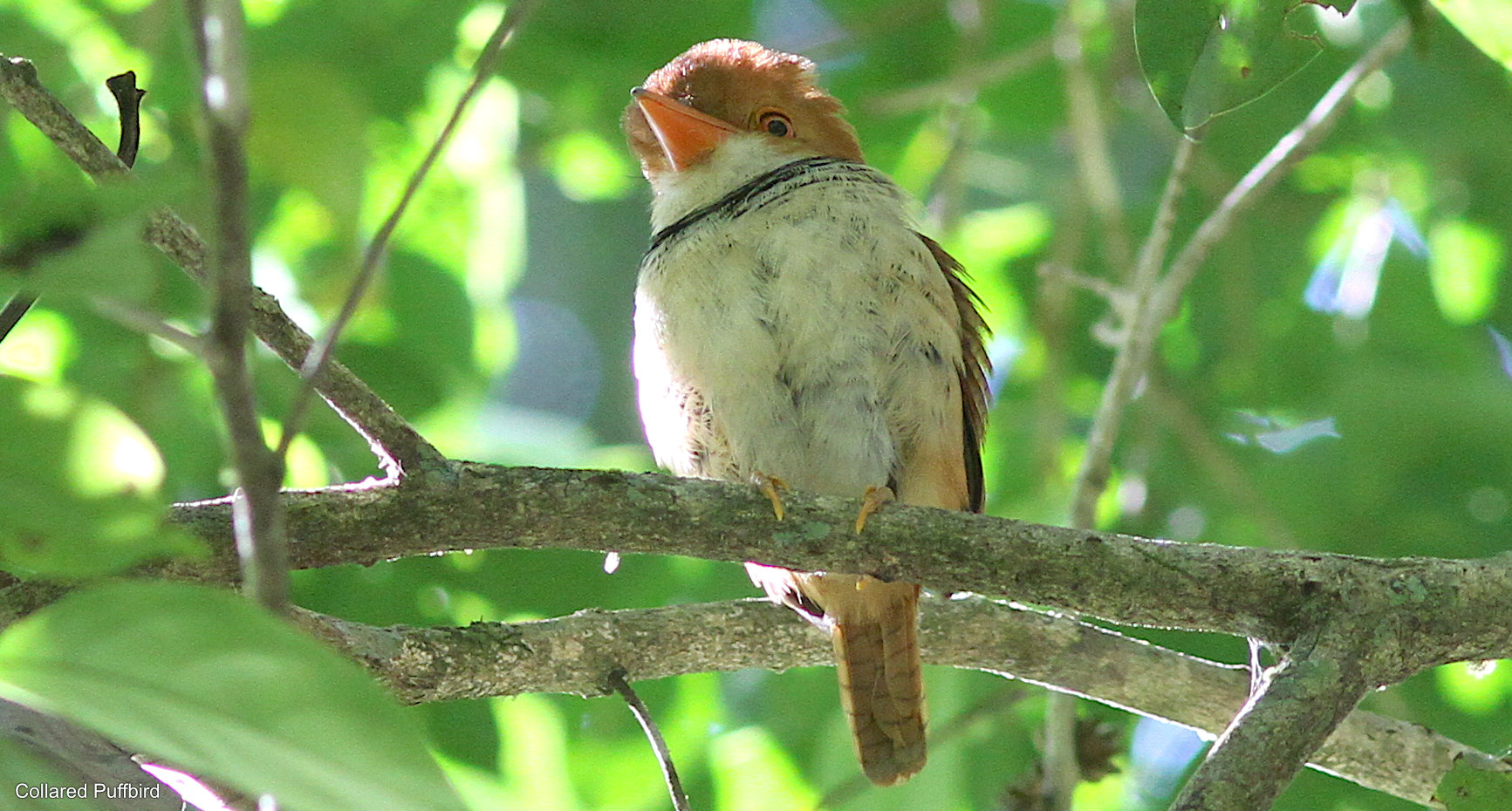
Although our flight had been delayed and we didn’t arrive at the start of the trail until midmorning, the Amazon rainforest had already bountifully rewarded our initial efforts. There was a flood of new birds and wave after wave of lifers poured from the forest. Before we even crossed the wooden bridge into the community of Mitú Cachivera, we were stopped in our tracks as a Spotted Puffbird confidently sat on an open perch right at eye level. A large arboreal ‘termitaria’ nearby was a potential nest site for this uncommon species. We marched on with plans to reach the white sand forest, one of the more unique habitats here, as soon as possible. Yet, we didn’t advance far as screeching Maroon-tailed Parakeets fed in a fruiting tree right above our heads, Yellow-tufted and Lineated Woodpeckers flew in, and an assortment of tanagers, doves, swallows and other species that prefer forest edge or open country all streamed into view. We eventually entered the white sand forest, where quartz-rich, sandy soils provide low amounts of nutrients and water leading to stunted trees and a dense understory. The white sand forest in Mitú is also interspersed with grassy, rocky clearings where the fine substrate is clearly visible. Several bird species are true white sand forest specialists while others are more commonly seen in this habitat than elsewhere. The lower stature of the forest also made it easier for us to sort through the scattered feeding flocks.
Although it was late morning and the temperature was invariably rising, we quickly located Bronzy Jacamar, Scale-breasted Woodpecker, tame Amazonian Antshrike, happily ticked Cherrie’s and Spot-backed Antwrens, and Brown-headed Greenlet, the latter a specialty of these scrubby forests. By late morning, the fierce equatorial sun was beating down and the mercury was creeping towards 35 degrees Celsius, but humidity was relatively low in this drier woodland. The Amazon basin is so rich in species that it is always worth trying for one more bird and we fastidiously played the harsh, wheezy call of a Red-legged Honeycreeper, which brought in several of these deep blue tanagers that appear to be the Neotropical answer to the Old World sunbirds. Alongside the feisty honeycreepers other passerines were responding to the call and we had great views of Rufous-bellied Euphonia, Paradise Tanager, Yellow-bellied Dacnis, and Purple Honeycreeper all flitting through the open canopy. Even a White-crowned Manakin came in to see what all the fuss was about.
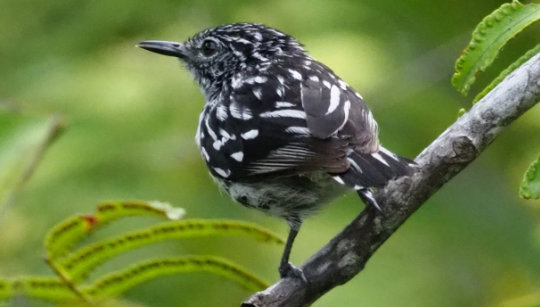
Suddenly, a tiny, nondescript bird appeared among the throng of feathers. The plain grey plumage with a thin tail and fine bill made it clearly a gnatcatcher. But wait a minute, we were in Mitú, deep in the Amazon of eastern Colombia, what the heck was a gnatcatcher doing here? After some minutes getting everyone onto this fast-moving bird, which was briefly joined by two more of its kind, it finally clicked that these were Rio Negro Gnatcatchers. The Rio Negro Gnatcatcher is by all standards drab: plain grey face, breast and upper parts, a whitish belly, and slim white tipped tail sum up this canopy dweller, but it is very rare. In fact, it has only been recorded a handful of times in Colombia and is infrequently seen in the rest of its range. Our local guide Agripino obtained good views of the birds and upon inquiry revealed that he had never seen this species before, a lifer for the local guide! Just three hours into our adventure and we had already found a major surprise, but that is Amazon birding, which never ceases to amaze, makes it impossible to run out of birds, and surprises literally wait around each bend in the trail. Yet, surprises appear to be the norm in Mitú, which was solidly carved into the birding map several years ago but remains relatively unexplored.
As the fruitcrow flies, the town of Mitú lies nearly six hundred kilometers southeast of Colombia’s capital, Bogotá, and can be reached via a one hour and a half nonstop flight. The local airline is not known for its on-time departures, but potential delays are well worth the wait for the avian riches that Mitú proffers. There are no other options anyway, since Mitú is not connected by road and a river journey would certainly take several weeks. The town of Mitú and nearby indigenous communities straddle the banks of the Vaupés River which further east merges with the larger Rio Negro in Brazil. Mitú is located far east in Colombia’s Amazon and the Brazilian border lies less than fifty kilometers distant.
Capital of the Vaupés department and home to 14,000 residents with many indigenous communities in the immediate area, Mitú is surprisingly developed given its remote location. A short walk around town reveals many shops, a modest supermarket, several restaurants, and a town square. The main hotel offers air conditioning and some rooms even have jacuzzies, the former amenity is very much appreciated, while the latter appears superfluous. Several restaurants in town provide filling meals. A new place even sells delicious sandwiches, which came in handy during our first morning as we rushed into the forest, where we enjoyed a good lunch and some rare gnatcatchers. Amidst the buildings, none higher than two stories, it is possible to forget that Mitú is a frontier town. Though, frontier town is a bit of a misnomer since Mitú does not just sit on the border of a wilderness but is surrounded by vast swathes of Amazon rainforest.
The birding potential around Mitú is almost limitless. A quick summary of the eBird hotspots for the area reveals that more than 580 species have been recorded within one to two hours of town. It is the mixture of habitats that boosts the diversity here. This heterogeneity is not apparent at first as one observes a sea of green that looks uniform from a distance. As the plane descends though, more detail becomes visible, including black water streams weaving through tall forest and rocky hills, and parts of the ancient Guiana Shield emerge like islands amid the greenery. Approaching the landing, the first garden and farm clearings, called chacras, appear. Even the forests surrounding Mitú are variable and include classic terra firme, unique white sand forest, and várzea forest along streams and rivers. In between, there are rock outcrops, hills that can be hiked for canopy level views, secondary scrub around town, moriche palm groves, and pastures that attract open country species usually not found within the dense rain forest. This juxtaposition, a small town with all necessary amenities and easy access to a wide variety of habitats, make Mitú one of the best birding sites in the entire Amazon.
Birders do not have to venture far from town to be immersed among classic Amazonian birds and a reliable spot lies just fifteen minutes from the hotel. Here, a level road leads to a small community via a covered bridge and the adjacent scrub, forest edge, and patches of várzea forest provide an excellent introduction. Some of the stunning species here include the impressive Amazonian Umbrellabird, raucous Red-throated Caracaras, several species of toucans and aracaris, macaws, jacamars and puffbirds, while flowering trees attract a wide array of hummingbirds, including the scarce Green-tailed Goldenthroat and Black-bellied Thorntail. A wooden bridge crossing a small side stream of the Vaupés River provides good views across a patch of flooded forest that holds such specialties as Amazonian Tyrannulet, Black-chinned Antbird, Striped Woodcreeper and if enough water is present a shy Sungrebe or flighty American Pygmy Kingfisher may make an appearance. The emergent trees surrounding this site are also great for Black-headed and colorful Orange-cheeked Parrots.
It was during one of my first visits to Mitú that another surprise appeared at the bridge after we heard the distinctive wing rattle of a Blue-throated Piping-guan. This large cracid came right into calls and showed well. While this is a common species in many parts of its wide range, it appears to be very rare in Mitú, either due to local hunting or may just be genuinely uncommon. Our local guide Agripino was all smiles since it was a lifer for him. A short walk past the bridge and through the local community offers the chance to hike to the flank of one of the inselbergs, where it is possible to obtain sweeping views across the unbroken canopy much like a natural canopy tower. From here it is possible to scan for raptors, puffbirds, cotingas, and parrots. For example, we spotted an annoyed Bat Falcon harassing a Black-and-white Hawk-Eagle from here and the sought-after Brown-banded Puffbird is present.
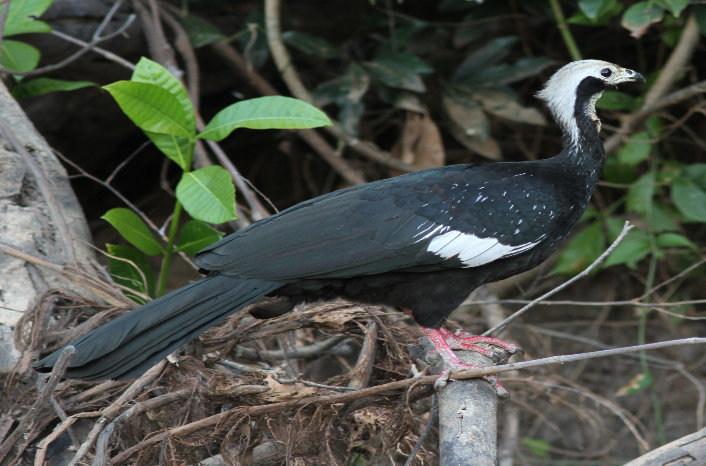
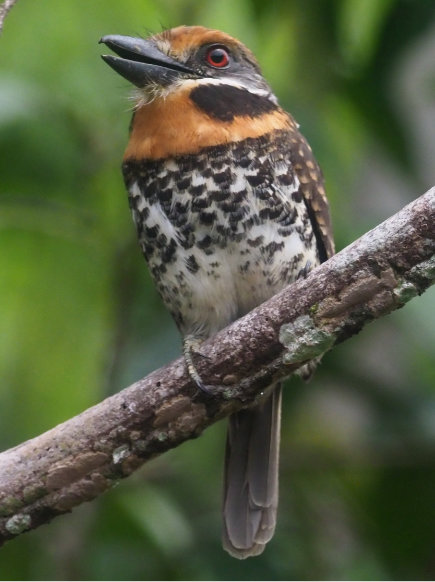
If conditions are too dry and water has vanished from side channels, it is possible to take a boat from Mitú to explore a small lagoon on the far side of the Vaupés River where Drab Water Tyrant, Blackish-grey Antshrike, and tiny Amazonian Streaked-Antwren all favor the riverside vegetation. An outing by boat is a must during any birding visit to the Amazon and at dusk the large numbers of Common Nighthawks swooping overhead reveal where this familiar species winters.
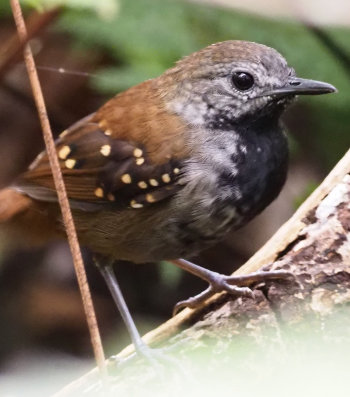
Mitú has some of the easiest access to the white sand forest and while some of the specialties are not outright endemic, they are much easier to find here than elsewhere. The overall diversity within this forest type tends to be lower compared to mature terra firme, but it does harbor a mixture species that are not found in other forests and birds that prefer more arid habitats. Not far from Mitú, several level trails weave through patches of white sand forest, past chacras, and even enter stretches of tall terra firme, a shift that occurs suddenly as the soil and hydrology change underfoot. This mixture of habitats within close proximity often leads to long bird lists and some of the specialties we look for include Cherrie’s Antwren, Grey-bellied Antbird, Citron-bellied Attila, Black and Yellow-crowned Manakins, and range-restricted Brown-headed Greenlet, while the impressive Azure-naped Jays range wider.
The dominant habitat around Mitú is terra firme rain forest, this forest tends to grow on undulating terrain and is not seasonally inundated by floodwaters. This is what most people think of as a typical rain forest with massive tree trunks stretching towards the sky, a shaded understory, and a tall canopy. There are many easy paths and side roads that enter secondary and primary terra firme forest within one hour of Mitú. Quiet roads are excellent for watching the canopy along their edges. Chacras are also common along roads and these clearings provide another opportunity to scope emergent trees along the forest edge for canopy species, including the colorful Pompadour Cotinga. Birding along a narrow trail in terra firme forest can be challenging but is immensely rewarding.
Some of the standout species possible here include Collared Puffbird, Rusty-breasted Nunlet, Gilded and Lemon-throated Barbets, Pavonine Quetzal, Great Jacamar, along with two very sought-after species, the spectacular Chestnut-crested Antbird that can best be found alongside an active army ant swarm and the retiring Tawny-tufted Toucanet. It is also along these roads and trails within the terra firme forest where most of Mitú’s fifty plus species of antbirds can be found with White-plumed and Banded Antbirds being just two of the more spectacular examples. An active army ant swarm in Mitú is a birding experience that no one will forget. Tinamous, anthrushes, antpittas, woodcreepers, foliage-gleaners and more will lead to many exciting hours stalking new species through the dark understory.
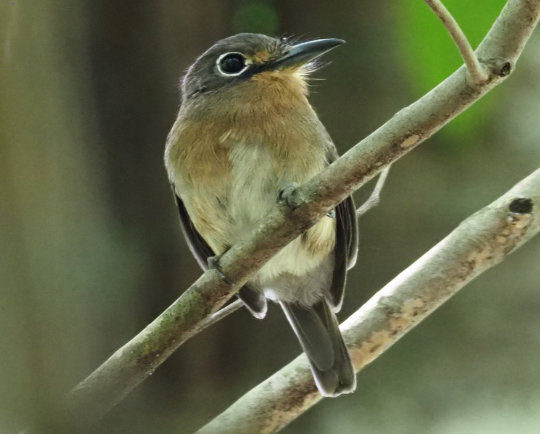
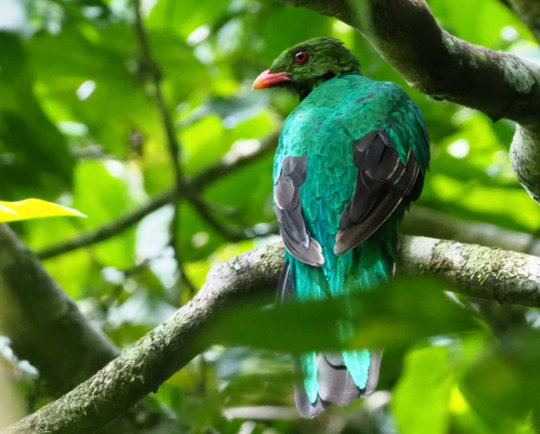
Several blackwater streams course through the forests around Mitú and these are one of the best places to catch up with the incredible Fiery Topaz. This bronze, wine, and gold colored hummingbird sports a long, forked tail, making the overall bird nearly twenty centimeters long. Right after sunrise, the Fiery Topaz will often visit open areas above a small stream to catch insects or display. The secondary tangles along streams and nearby roads also hold the rare Black Bushbird and Orinoco Piculet. Another specialized stream habitat is formed by a cluster of rapids along the Vaupés River that attract the gorgeous Black-collared Swallow which feed and nest nearly exclusively alongside turbulent waters.
The Amazon rainforest has seasonality, some easily observed while other patterns are more mysterious. Precipitation is an easy pattern to discern and in Mitú the summer months see the highest rainfalls, although it can rain heavily any time of the year. We experienced this sudden rain during my last visit to Mitú as we drove to the start of a trail leading to a natural rock overhang deep in the forest. Rock outcrops are the favoured habitat of the Guianan Cock-of-the-rock and these large cotingas are dependent on overhangs for nesting with males often displaying in the vicinity. As we readied our gear for the walk, dark clouds drifted in from the west and within minutes a deluge was pelting the forest with temperamental gusts bending trees. We waited out the worst of it and then set out into the dripping forest. The rain had abated, but the clouds continued to darken the sky, making it very gloomy. Nothing was moving or calling after the storm, but we hoped to at least find a Guianan Cock-of-the-rock, which theoretically should be glowing orange even in dim light. We reached the rock outcrop and carefully advanced. First, we spotted a female on a nest, a cup of mud and plant material plastered onto the rock face, and then saw the unmistakable flash of a male Guianan Cock-of-the-rock fly through the forest. We moved slowly, not wanting to scare off the birds from their display area. Agripino was in the front and suddenly became very animated, pointing into the canopy above him. We were still underneath the rocky overhang so couldn’t see what he was pointing at. He then quickly tried to describe what he had spotted but could not remember the exact name. From his description, I figured it was possibly a Spix’s Guan, another cracid that is relatively rare in Mitú. We crept forward slowly and carefully scanned the canopy, when I suddenly spotted a huge bird on a stout horizontal limb, a curassow. Wow, another species that is almost never seen by visiting birders. The shy curassow vanished, but we were able to track it down for great views and confirmed it to be a Black Curassow. After yet another surprise, we wondered if the Guianan Cock-of-the-rock was still around and true to form it was glowing on its favored perch.
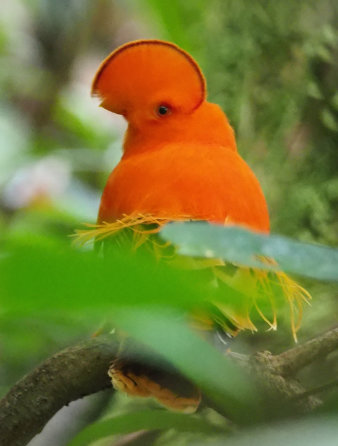
Among birds the most obvious seasonality is the presence of Blackpoll Warblers which are common migrants, spending the northern winters in the Amazon. On the other hand, intra-tropical migration is less well understood and movements, irruptions, and vagrancy within the Amazon Basin are even more interesting. During one visit in November we birded along the well-known Pipeline Trail, carefully checking fruiting trees, finding a plethora of tanagers when we spotted a pair of White-bellied Dacnis. Thrilled to find this rare and unpredictable species, I made sure everyone got to see them, explaining our great fortune and incredible luck, excitedly stating “you are unlikely to see this species again”. Of course, we saw White-bellied Dacnis every day thereafter in Mitú and several folks quoted me every time we noted one. Yet, during most visits to the Mitú area, White-bellied Dacnis are nowhere to be found. The species is clearly a seasonal visitor, but the phenology of its movements is not known. This seasonality struck me again during my last visit to Mitú, when parrots, macaws, toucans, aracaris, and cotingas were very thin on the ground, clearly the lack of these frugivores indicated that their preferred food was elsewhere. Flowering must have been in full swing though as hummingbirds showed in good numbers and we recorded the locally scarce Rufous-throated Sapphire regularly, found the rare Black-throated Brilliant and even saw the beautiful Gould’s Jewelfront. With each sighting we added another piece to the puzzle, but this unpredictable movement of birds provides another exciting facet to birding in Mitú.
With a treasure trove of lifers in our bags and several surprises in our pockets, we returned for the final morning of our Mitú visit to the same spot where it all began. The narrow trail through the white sand forest was a bit more familiar by now, but a slew of new birds and specialties made us feel like it was our first outing. Despite having spent several days in the area already, we added Grey-bellied Antbird, very rare Duida Woodcreeper, super views of Black and Yellow-crowned Manakins, and the unique Citron-bellied Attila. With a scheduled afternoon flight and packing looming, we hurried down the trail where the scarce Saffron-crested Tyrant Manakin was already calling. We had excellent scope views of this rather nondescript manakin before walking back and heading into town. This being the Amazon though there is always something else to see and with five minutes to spare we stopped at a palm grove in the middle of town. Within minutes we had the spectacular and habitat-specific Point-tailed Palmcreeper fly in for scope filling views, another highlight to one of the best birding sites in Amazonia. Mitú never ceases to amaze, challenge, and surprise. Join us in Mitú during either our Colombia – 1000 Birds Mega Tour or Mitú Extension. It is also possible to let our Tailor-Made department put together a Mitú birding adventure.
Photos by Stephan Lorenz
